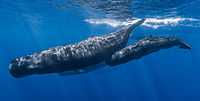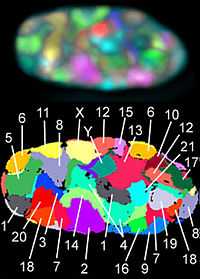
A pod of sperm whales swims off the coast of Mauritius. Credit: Gabriel Barathieu.
Abstract concept generator is a lecture and an article as part of semantics.
You are free to take this quiz based on an abstract concept generator at any time.
To improve your score, read and study the lecture, the links contained within, listed under See also, and in the reasoning template. This should give you adequate background to get 100 %.
As a "learning by doing" resource, this quiz helps you to assess your knowledge and understanding of the information, and it is a quiz you may take over and over as a learning resource to improve your knowledge, understanding, test-taking skills, and your score.
A suggestion is to have the lecture available in a separate window.
To master the information and use only your memory while taking the quiz, try rewriting the information from more familiar points of view, or be creative with association.
Enjoy learning by doing!
Quiz
Hypothesis:
- It appears that life forms with central nervous systems of at least 200 gms, or having such complexity are capable of thinking and conceiving in the abstract; i.e., possess an abstract concept generator.

This is an image of a Lewis rat. Credit: Charles River Laboratories.
The findings demonstrate a statistically systematic change from the status quo or the control group.
“In the design of experiments, treatments [or special properties or characteristics] are applied to [or observed in] experimental units in the treatment group(s).[1] In comparative experiments, members of the complementary group, the control group, receive either no treatment or a standard treatment.[2]"[3]
Def. a “short and/or incomplete realization of a certain method or idea to demonstrate its feasibility"[4] is called a proof of concept.
Def. evidence that demonstrates that a concept is possible is called proof of concept.
The proof-of-concept structure consists of
- background,
- procedures,
- findings, and
- interpretation.[5]
See also
References
- ↑ Klaus Hinkelmann, Oscar Kempthorne (2008). Design and Analysis of Experiments, Volume I: Introduction to Experimental Design (2nd ed.). Wiley. ISBN 978-0-471-72756-9. http://books.google.com/?id=T3wWj2kVYZgC&printsec=frontcover.
- ↑ R. A. Bailey (2008). Design of comparative experiments. Cambridge University Press. ISBN 978-0-521-68357-9. http://www.cambridge.org/uk/catalogue/catalogue.asp?isbn=9780521683579.
- ↑ "Treatment and control groups, In: Wikipedia". San Francisco, California: Wikimedia Foundation, Inc. May 18, 2012. Retrieved 2012-05-31.
- ↑ "proof of concept, In: Wiktionary". San Francisco, California: Wikimedia Foundation, Inc. November 10, 2012. Retrieved 2013-01-13.
- ↑ Ginger Lehrman and Ian B Hogue, Sarah Palmer, Cheryl Jennings, Celsa A Spina, Ann Wiegand, Alan L Landay, Robert W Coombs, Douglas D Richman, John W Mellors, John M Coffin, Ronald J Bosch, David M Margolis (August 13, 2005). "Depletion of latent HIV-1 infection in vivo: a proof-of-concept study". Lancet 366 (9485): 549-55. doi:10.1016/S0140-6736(05)67098-5. http://www.ncbi.nlm.nih.gov/pmc/articles/PMC1894952/. Retrieved 2012-05-09.
External links
| Anthropology resources |
|---|
| | Activities | | | | Articles | | | | Categories |
Agriculture ·
Anthropology ·
Archaeology ·
Art ·
Arts ·
Biological Anthropology ·
Culture ·
Dominant group ·
Education ·
Evolutionary anthropology ·
Evolutionary psychology ·
Genetics ·
History ·
Humanities ·
Language ·
Linguistics ·
Literature ·
Medicine ·
Mythology ·
Philosophy ·
Psychology ·
Religious studies ·
Semantics ·
Social anthropology ·
Social psychology
| | | Courses | | | | Fields | | | | Glossaries | | | | Lectures | | | | Lessons | | | | Lists |
| | | Original research | | | | Portals |
History ·
Social sciences
| | | Problem sets | | | | Projects | | | | Proposals | | | | Quizzes | | | | Schools |
Agriculture ·
Alternative medicine ·
Anthropology ·
Archeology ·
Classics ·
Dentistry ·
Gastronomy ·
History ·
Life ·
Medicine ·
Pharmacy ·
Veterinary medicine
| | | Topics | |
|
| Archaeology resources |
|---|
| | Activities | | | | Articles | | | | Categories |
Category:Archeology ·
Category:Archaeometry or Scientific Archaeology ·
Category:Sciences
| | | Courses |
An Introduction to Historical Archaeology
| | | Lectures | | | | Lessons | | | | Original research |
Holocene climatic optimum ·
Ice core brittle zone
| | | Problem sets | | | | Quizzes | | | | Schools |
Architecture ·
Business ·
Chemistry ·
Computer science ·
Conservation sciences ·
Construction ·
Earth science ·
Engineering ·
Geology ·
History ·
Physics and Astronomy ·
Tourism
| | | Topics |
Archeology ·
Earth science ·
Engineering geology ·
Geochemistry ·
Geophysics ·
Historical Archaeology ·
Historical geology ·
Hydrogeology ·
Mineralogy ·
Mining geology ·
Oceanography ·
Paleoclimatology ·
Paleontology ·
Particle physics ·
Petroleum geology ·
Petrophysics ·
Seismology ·
Soil science ·
Stratigraphy ·
Volcanology
|
|
| Dominant group |
|---|
| | Activities | | | | Courses | | | | Definitions & Meaning | | | | Diffusion |
Aristocracies ·
Authors ·
Empires ·
Hierarchies ·
Killers ·
Journals ·
Languages ·
Slavery ·
Wealth
| | | Fields | | | | Income opportunities | | | | Lectures | | | | Lessons | | | | NEH proposal sections | | | | NSF proposal sections | | | | Quizzes | | | | Resources | |
|
| Humanities resources |
|---|
| | Activities | | | | Articles | | | | Categories |
Agriculture ·
Anthropology ·
Archaeology ·
Art ·
Arts ·
Culture ·
Dominant group ·
Education ·
Genetics ·
History ·
Humanities ·
Language ·
Linguistics ·
Literature ·
Medicine ·
Philosophy ·
Psychology ·
Religious studies ·
Semantics ·
Social psychology
| | | Courses | | | | Fields | | | | Glossaries | | | | Lectures | | | | Lessons |
| | | Lists |
| | | Original research | | | | Portals |
History ·
Social sciences
| | | Problem sets | | | | Projects | | | | Proposals | | | | Quizzes | | | | Schools |
Agriculture ·
Alternative medicine ·
Anthropology ·
Archeology ·
Classics ·
Dentistry ·
Gastronomy ·
History ·
Life ·
Medicine ·
Pharmacy ·
Veterinary medicine
| | | Topics | |
|
| Linguistics resources |
|---|
| | Lectures | | | | Articles | | | | Courses | | | | Activities | | | | Lessons | | | | Problem sets |
| | | Quizzes | | | | Lists | | | | Projects | | | | Topics |
Computational linguistics ·
Computer programming ·
Foreign Language Learning
| | | Schools |
Computer science ·
Language and literature ·
Linguistics ·
Media Studies
| | | Fields | | | | Proposals | |
|
| Mathematics resources |
|---|
| | Activities | | | | Articles | | | | Categories |
Algebra ·
Algorithms ·
Analysis ·
Applied mathematics ·
Arithmetic ·
Basic mathematics ·
Calculus ·
College algebra ·
Complex analysis ·
Complex Function Theory ·
Complex numbers ·
Discrete mathematics ·
Drilling and threading ·
Elementary mathematics ·
Equations ·
Finite element analysis ·
Finite element software ·
Floating point ·
Formulas ·
Functional analysis ·
Functions ·
Further Study, College Algebra ·
Further Study, Introduction to Limits ·
Geomathematic ·
Geometry ·
Introduction to Topology ·
Laboratory on Mathematics and Mathematics Education ·
Mathematical analysis ·
Mathematical physics ·
Mathematical proofs ·
Mathematical theorems ·
Mathematics Media ·
Numerical analysis ·
Numerical methods ·
Olympiads ·
Philosophy of mathematics ·
Pre-Calculus ·
Probability ·
Proofs ·
Pure Mathematics ·
Real numbers ·
Representation theory ·
School of Mathematics ·
Secondary Math Courses ·
Secondary Math Lessons ·
Secondary Math Quizzes ·
Systems theory ·
Trigonometry ·
Units of measurement
| | | Courses | | | | Glossaries | | | | Lectures | | | | Lessons | | | | Lists | | | | Portals | | | | Problem sets | | | | Projects | | | | Quizzes | | | | Schools |
Biomathematics ·
Mathematics
| | | Topics | |
|
| Reasoning |
|---|
| | Lectures | | | | Articles | | | | Courses | | | | Topics | | | | Schools |
Biomathematics ·
Computer Science ·
Law ·
Linguistics ·
Mathematics ·
Philosophy ·
Psychology
| | | Activities |
| | | Lessons | | | | Quizzes |
Abstract concept generator/Quiz ·
Affirmation/Quiz ·
Answer/Quiz ·
Argumentation/Quiz ·
Assent/Quiz ·
Belief/Quiz ·
Canons/Quiz ·
Categorical Syllogism/Quiz ·
Certainty/Quiz ·
Comparison/Quiz ·
Computer Logic/Quiz ·
Conclusion/Quiz ·
Correctness/Quiz ·
Credulity/Quiz ·
Criteria/Quiz ·
Deduction/Quiz ·
Demonstration/Quiz ·
Discovery/Quiz ·
Discrimination/Quiz ·
Disillusionment/Quiz ·
Dissent/Quiz ·
Eccentricity/Quiz ·
Elementary logic/Quiz ·
Error/Quiz ·
Evidence/Quiz ·
Evolution/Quiz ·
Experiment/Quiz ·
Fact/Quiz ·
Foolishness/Quiz ·
Formalness/Quiz ·
Gamble/Quiz ·
Hypothesis/Quiz ·
Idea/Quiz ·
Ignorance/Quiz ·
Illusion/Quiz ·
Impossibility/Quiz ·
Improbability/Quiz ·
Incredulity/Quiz ·
Indiscrimination/Quiz ·
Induction/Quiz ·
Inference/Quiz ·
Insanity/Quiz ·
Intellect/Quiz ·
Intuition/Quiz ·
Judgment/Quiz ·
Knowledge/Quiz ·
Logic/Quiz ·
Mathematical proofing & reasoning/Quiz ·
Maxim/Quiz ·
Measurement/Quiz ·
Metalogic/Quiz ·
Metamathematics/Quiz ·
Misjudgment/Quiz ·
Negation/Quiz ·
Normative/Quiz ·
Overestimation/Quiz ·
Philosophical logic/Quiz ·
Philosophy/Quiz ·
Possibility/Quiz ·
Prejudgment/Quiz ·
Premise/Quiz ·
Primary mathematics:Boolean logic/Quiz ·
Principle/Quiz ·
Probability/Quiz ·
Proof/Quiz ·
Proposition/Quiz ·
Propositional logic/Quiz ·
Qualification/Quiz ·
Reasoning/Quiz ·
Sanity/Quiz ·
Semantics/Quiz ·
Solution/Quiz ·
Sophistry/Quiz ·
Theoretical astronomy/Quiz ·
Theoretical radiation astronomy/Quiz ·
Theory/Quiz ·
Theory of original research/Quiz ·
Thought/Quiz ·
Topic/Quiz ·
Truth/Quiz ·
Unbelief/Quiz ·
Uncertainty/Quiz ·
Underestimation/Quiz ·
Validity/Quiz
| | | Original research | | | | Proposal |
| | | History | | | | Projects |
| | | Glossaries | | | | Portals |
Portal:Computer Science ·
Portal:Mathematics
|
|
| Semantics resources |
|---|
| | Lectures | | | | Articles | | | | Courses | | | | Activities | | | | Lessons | | | | Problem sets |
| | | Quizzes | | | | Lists | | | | Projects | | | | Topics |
Computational linguistics ·
Computer programming ·
Foreign Language Learning
| | | Schools |
Computer science ·
Language and literature ·
Linguistics ·
Media Studies
| | | Fields | | | | Proposals | |
|
| Universal translator |
|---|
| | Articles | | | | Courses | | | | Definitions & Meaning | | | | Fields | | | | Lectures | | | | Lessons | | | | Projects | | | | Schools |
Computer science ·
Language and Literature ·
Linguistics ·
Media Studies
| | | Topics |
Computational linguistics ·
Computer programming ·
Foreign Language Learning
|
|
 This is a research project at http://en.wikiversity.org
This is a research project at http://en.wikiversity.org
 |
Educational level: this is a research resource. |
 |
Resource type: this resource is a quiz. |
 |
Subject classification: this is an archaeology resource. |
 |
Subject classification: this is a biology resource . |
 |
Subject classification: this is a genetics resource. |
.jpg) |
Subject classification: this is a humanities resource. |
 |
Subject classification: this is a psychology resource . |
 |
Subject classification: this is a semantics resource. |


![]() This is a research project at http://en.wikiversity.org
This is a research project at http://en.wikiversity.org